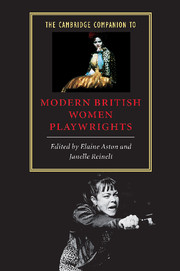Book contents
- Frontmatter
- 1 A century in view: from suffrage to the 1990s
- Part I Retrospectives
- Part II National tensions and intersections
- Part III The question of the canon
- Part IV The subject of identity
- Editors’ note
- 13 Small island people: black British women playwrights
- 14 Writing outside the mainstream
- 15 Lesbian performance in the transnational arena
- Index
14 - Writing outside the mainstream
from Part IV - The subject of identity
Published online by Cambridge University Press: 28 May 2006
- Frontmatter
- 1 A century in view: from suffrage to the 1990s
- Part I Retrospectives
- Part II National tensions and intersections
- Part III The question of the canon
- Part IV The subject of identity
- Editors’ note
- 13 Small island people: black British women playwrights
- 14 Writing outside the mainstream
- 15 Lesbian performance in the transnational arena
- Index
Summary
Theatre outside the mainstream has tended to be a director’s rather than a writer’s theatre. This is not to say that experimental theatre has not offered new opportunities to writers, or that it has stifled the writer’s voice. On the contrary, over the past two or three decades theatre has functioned as one of the most important cultural spaces for writers to experiment with form - and this has been especially important for women. The opportunity to collaborate with artists from other disciplines and to find new ways to explore the limits of stage language has generated a new kind of writing for the theatre, outside the confines of the well-made play; writing which is linked to developments in film and the novel and is conversant with the visual arts and dance as well as the language of television and film. Political theatre, physical and visual theatre, small-scale and fringe theatre, and collaborative work with the visual arts and dance have all created a contemporary theatre scene in Britain which is highly interdisciplinary, and which has functioned as an experimental arena in which the relationship between image, speech, and action has come under scrutiny.
It is outside the mainstream that women have been able to create new work informed by debates in feminism about the body, identity, and representation in particular. In the 1970s radical political and artistic feminist theatre companies helped to create the conditions for exploratory work by commissioning the work of women theatre-makers and writers [see pp. 60-1]. Of the many groups producing innovative work with writers were the visual and physical Blood Group, Scarlet Harlots (renamed Scarlet Theatre in the 1980s) and Monstrous Regiment. Certain key venues, often with women directors, also helped to create a climate open to experimentation.
- Type
- Chapter
- Information
- The Cambridge Companion to Modern British Women Playwrights , pp. 253 - 252Publisher: Cambridge University PressPrint publication year: 2000



